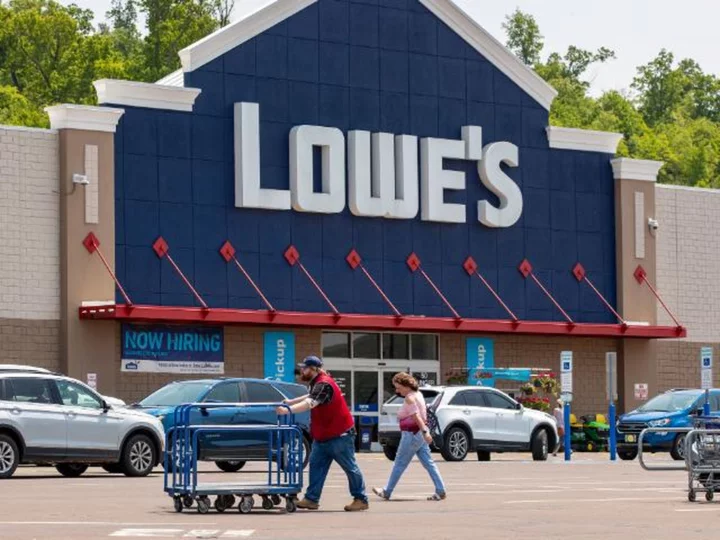Americans turned into DIY fanatics during the pandemic, beautifying their apartments, homes and condos while they were stuck inside and tired of looking at the same drab interior every day.
But the Covid emergency is over, prices are (much) higher, consumers are growing fearful of a recession and people are spending less at Lowe's and Home Depot.
Lowe's on Tuesday lowered its profit and sales outlook for the year, saying consumers were spending less on home improvement. It comes on the heels of rival Home Depot also posting disappointing sales and a somber forecast last week.
"We are updating our full-year outlook to reflect softer-than-expected consumer demand for discretionary purchases," said Ellison. "We remain optimistic about the medium-to-long-term outlook for home improvement."
Shares of Lowe's were up 2% Tuesday.
That optimism also hinges on pursuing a different customer, where having rural stores "gives us an opportunity to drive sustainable profit growth due to the much lower expense base," said Ellison.
Home improvement blues
The end of a protracted robust investment by homeowners in DIY home improvement projects during the pandemic has forced Lowe's and rival Home Depot to look for ways to offset a business slowdown.
"Lowe's is suffering from a case of the home improvement blues," said retail expert Neil Saunders, managing director at Global Data, in a note Tuesday.
On the consumer side, a slowing housing market is dragging down the number of people undertaking projects, Saunders said.
"This has been unhelpful to Lowe's, although arguably the burden falls more on Home Depot as movers tend to undertake heavier and more serious DIY, which traditionally favors Lowe's larger rival," he said.
Bill Darcy, CEO of the National Kitchen & Bath Association, said homeowners are nervous about the economy. Some have paused large-scale projects, while others are shifting towards smaller, lower-cost projects, he said.
Among the trends he's observed: Consumers are downgrading brand names in favor of lower prices, they're using factory-made cabinetry as opposed to custom carpentry and buying less expensive countertops.
Darcy said project completions are beginning to waver. "Year-over-year project completions are up 1.8% in the first quarter of 2023 on a year-over-year basis, decelerating from 6.5% in the fourth quarter of 2022. Consumers are pausing large-scale projects until economic conditions stabilize," he said.
Slowing sales
Lowe's said sales at stores open at least a year fell 4.3% in the past quarter. Ellison noted lumber prices have fallen through the floor as supply and demand have finally rebalanced after years of supply chain constraints. The CEO also blamed poor weather, as rain storms in the West weren't exactly the most favorable conditions for building a shed or installing new soffits.
But discretionary purchases at retailers all over America are saying the same thing in unison: Consumers aren't spending on stuff they don't need anymore. Target, Walmart and Home Depot over the past couple weeks all noted that discretionary purchases are down across the board. People are spending more on groceries and other essentials and less on clothes and gutters.
Consumers aren't completely throwing in the towel yet: Travel spending remains higher. But it seems inflation has finally caught up with America. Prices are 4.9% higher now than they were a year ago, the Labor Department reported earlier this month.
For the first quarter, Lowe's said overall sales fell 5.5% to $22.3 billion. Profit fell 3% to $2.3 billion.
The company now expects annual sales to come in somewhere between $87 billion and $89 billion this year, down from its previous estimate of $88 billion to $90 billion.
At stores open at least a year, Lowe's now predicts sales will fall as much as 4%. It had previously expected sales to be flat to down 2%. And Lowe's lowered its profit guidance by 3% from its original forecast.
A low-cost market
Lowe's needs a new, more dependable engine for growth amid slowing sales in its vast fleet of urban retail stores. It appears to have found it: Rural America.
"While in years past, our penetration of rural and remote stores was viewed as a competitive disadvantage, we now expect that these stores will be a key component of our operating profit growth over the next 3 to 5 years," Lowe's CEO Marvin Ellison, said Tuesday during the company's earnings call with analysts.
The home improvement retailer also announced that it was scaling its rural store format to as many as 300 additional stores by year end, with the rural-focused stores offering "a wider offering of farm, ranch and outdoor products that positions Lowe's as a one-stop shop to make it convenient for rural customers to get what they need in one shopping trip."
Lowe's said its rural store would cater to the specific indoor and outdoor needs of rural homeowners with product categories such as pet, livestock, trailers, fencing, utility vehicles, clothing and specialized hardware.
The company's enthusiasm about pushing more aggressively into smaller rural communities comes as its sales in larger metropolitan markets has slowed post-pandemic.
Lowe's said it has seen success with pilots set up a year ago to test stores tailored for rural shoppers.
"When we look at the pilot stores where we've been very diligent on going after those specific categories of apparel, farm and ranch types of items as part of our expansion opportunity, we actually saw sales per square foot improve," said Ellison.
"We see this as a unique opportunity with an expense base that is lower. If you can have a lower expense base, then you can improve sales per square footage," he said.
Ellison said it might even make sense for Lowe's to introduce specific products that outperfomed in sales with rural shoppers into its nonrural store locations.
"We're seeing things like ATVs, having no idea if customers will respond, and it's been an incredible growth category for us," said Ellison. "We are finding categories in these rural stores that we think will be relevant in nonrural locations."









